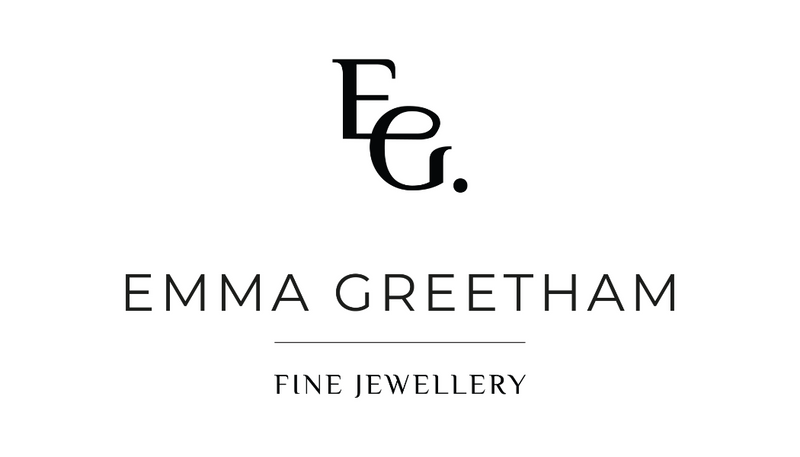How to Choose a Diamond
At Emma Greetham Fine Jewellery, we will always provide you with the advice you need to make a confident, informed choice, ensuring you receive a piece of jewellery that will be treasured for generations.
We will encourage you to aim for a balanced combination of size + quality, + can show you a range of options within your price range. All our engagement ring principle diamonds are independently certificated by the GIA, giving you confidence that your diamond is accredited, guaranteed + traceable.
Buying diamonds can feel overwhelming, but we are here to guide you through the process with honest, expert advice. The Four C's - cut, clarity, colour + carat are the main characteristics that will determine the price + beauty of a diamond. We have put together a simple guide to outline these characteristics + help you understand the basics.
Carat Weight

When considering the size of the diamond you would like, you will need to think about carats. Carats are actually a measurement of weight rather than size and are broken down in to 'points'. 1ct = 100pts 1/2ct =50pts + so on. It is possible to estimate the size of a diamond based on its weight, but every diamond is unique and there will be slight variations depending on how the stone is cut.
The higher the carat weight, the bigger the diamond + the more it will cost. Depending on your budget you may have to think about how you would compromise between size + quality. Would you rather have a the biggest diamond you can afford even if that means lowering the colour + clarity? Is your preference small but perfectly formed? Or are you looking for something in the middle with a nice balance of quality + size?
Cut
A diamonds cut is not to be confused with its shape. Cut refers to the quality of a diamonds cut + is described on a scale of terms;
Excellent > Very Good > Good > Fair > Poor

An expert cut will enhance a diamonds natural brilliance, fire + scintillation, whilst also making the most of its colour + clarity. Badly cut diamonds are flat, muted + lack sparkle. A poorly cut diamond might look nice enough when it's new + clean but will quickly dull + lack lustre with wear.
The cut of a diamond is much more difficult to grade than other characteristics, and while round brilliants have industry-set laboratory grades, there is always an element of personal (although always expert) perception. Round brilliant cuts are the only shape to be awarded all three cut grades (cut, polish + symmetry) whilst all other fancy shapes will be graded on polish + symmetry.
Choosing a diamond with excellent + very good grades will ensure your diamond is bright + sparkly with the best balance of fire + brilliance.
Colour
White diamonds are graded for colour on an alphabetical scale from D - Z. When talking about colour, this scale refers only to white diamonds. Pink, green, yellow, blue + other naturally-coloured diamonds are called 'fancy' coloured diamonds are are graded differently.
The most rare + beautiful diamonds are colourless and awarded a D colour grade. There are no A, B or C grades. As the scale works its way through the alphabet diamonds will exhibit yellow, green + brown hues. Generally diamonds in the D-F categories are considered colourless, those that fall into the G-I are close to colourless + the J-Z group have clear colour attributes.

At Emma Greetham Fine Jewellery, we generally recommend diamonds from D-H colour. Where possible we will show you loose diamonds so you can inspect them from all angles under a diamond lamp + natural light, too.
Clarity
Clarity refers to the blemishes + inclusions in a diamond + is graded on a scale using combinations of letters + numbers from FL (flawless) to I1-I3 (included).
The GIA Diamond Clarity Scale has 6 categories, some of which are divided, for a total off 11 specific grades.
- Flawless (FL) No inclusions + no blemishes visible under 10x magnification
- Internally Flawless (IF) No inclusions visible under 10x magnification
- Very, Very Slightly Included (VVS1 + VVS2) Inclusions so slight they are difficult for a skilled grader to see under 10x magnification
- Very Slightly Included (VS1 + VS2) Inclusions are observed with effort under 10x magnification, but can be characterised as minor
- Slightly Included (SI1 + SI2) Inclusions are noticeable under 10x magnification
- Included (I1, I2 + I3) Inclusions are obvious under 10x magnification which may affect transparency + brilliance

When a diamond is forming deep within the earth, tiny particles of other materials may be included within the stone, other minute diamonds may become trapped inside, or small cracks (known as feathers) may appear + create an opaque effect. These internal features are called inclusions. Cracks or features on the surface of the diamond are called blemishes.
It is important to note that clarity is graded under 10x magnification + not with the naked eye. As you go down the scale the number + size of inclusions visible will increase, which will effect the beauty + value of the diamond.
Flawless diamonds are extremely rare + demand the highest prices. Even the most discerning of customers will usually consider a few grades below the very top grade. At Emma Greetham Fine Jewellery we find that VS1/2 + SI grades are often a good middle ground. These diamonds will have some small inclusions, but you shouldn't be able to spot them without the aid of a 10x jewellers loupe. This is referred to as 'eye-clean' and stones that fall in between the VS and top SI grades often represent excellent value for money.

